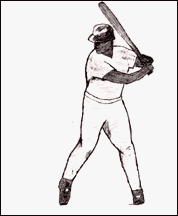Subject: Linear and rotational movement of the body's mass do not occur at the same time.
It has long been accepted that in order to develop power, the batter must have forward body movement during the swing. For example, Charley Lau's rule #6 in his book, "The Ten Absolutes of Good Hitting," states, "Making a positive, aggressive motion toward the pitcher." It was also believed that in order to develop the required kinetic energy for the swing, the body (axis) had to move forward 12 to 18 inches. But over time most coaches have conceded that a hard, aggressive move is not only unnecessary, but it can be counterproductive. Today, these coaches recommend a short soft stride, but still maintain that a weight shift is essential.
Many coaches do not understand that there is a clear distinction between the body's forward movements to prepare the launch position and the body's rotational movement during the actual swing. Most hitters will stride forward as they prepare to swing. However, before the actual swing is initiated (hand acceleration and body rotation begins) the batter will come to full balance and there is no further forward movement of the body. Lateral and rotational movements of the body do not occur at the same time.
Test after test concludes that the forces required to accelerate the bat head into its arc are not generated from lateral movement of the hands and body. The bat's rate of angular displacement (bat speed) is derived from the amount of torque (push/pull action of the arms) and how much of the body's rotational energies are transferred (via a circular hand-path).

The batter has rotated (inward turn) to the launch position and completed his timing step. The inward turn leaves his hips leading the shoulders by about 20 to 30 degrees in the launch position. His front toe has been planted and forward motion has slowed to a stop -- he is ready to initiate the swing. Now, assume that a stake has been driven down through the batter's head and body, out the butt and into 6 feet of concrete. This will be the axis the batter will rotate on.
Rotating around a stationary axis (neck and spine) is a "ground-up" movement where the muscles in the knees, hips and torso are all fired in unison to drive rotation. The lead knee and leg rotate and straighten to drive the front hip in an arc back toward the catcher at the same rate the back leg rotates the back hip around toward the pitcher. Both hips rotating evenly allow the axis to remain stationary. Using the large muscles of both legs will maximize the power of rotation.
After the inward turn, the hips will continue to rotate ahead of the torso and shoulders. This is not due to sequential timing of mechanics (stride - rotate hips while keeping shoulders closed - swing). Although the torso muscles are also contacting, the hips continue leading the shoulders because the upper-body must overcome the inertia created by accelerating the bat-head back toward the catcher. Accelerating the bat-head in an arc back toward the catcher (rotational) develops a much greater load than sliding the bat's knob lengthwise at the pitcher (linear). Thus, shoulder rotation will slightly trail hip rotation.
Therefore, when a batter uses a one piece rotation, I know that his or her shoulders kept up with the hips because there was little or no load for rotation to overcome (indicating linear transfer mechanics). Due to poor linkage or mechanics, the batter does not generate early bat speed. The load was overcome by the batter sliding the knob at the pitcher. Under this low load condition, the shoulders can rotate right with the hips.

![]()